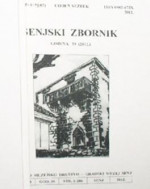Izvješće o probnom arheološkom istraživanju lokaliteta Senj – Pavlinski trg 2012
Report about the trial archaeological Excavation of the Senj Locality - Pavlinski trg 2012
Author(s): Vedrana Glavaš, Miroslav GlavičićSubject(s): Archaeology, Local History / Microhistory, 13th to 14th Centuries, 18th Century, 19th Century
Published by: Senjsko muzejsko društvo i Gradski muzej Senj
Keywords: Senj; church and monastery of St. Nicholas; Modern Age graves; medallions; pendant crosses;
Summary/Abstract: The main aim of the trial sounding research on today’s Pavlinski trg (Pauline Square) in Senj was to, as much as possible with the sounder system, uncover traces of the architecture of the Dominican and then Pauline Church of St. Nicholas with a monastery, which were located in this area since before 1378, when in historical sources the first mention of the church was noted, and from 1380, when the monastery was first mentioned, to 1874, when due to disrepair the complex was demolished. In the excavated soundings, after the removal of the recent levelling layer of the square, at circa 40 cm deep the walls of a church-monastery structure were uncovered. The walls were built by the horizontal layering of roughly processed larger carved stones in mortar, and it is noticeable that in the structure of the wall between the rows of stones they also inserted rows of bricks, probably for statical reasons. The foundation footprint of the walls was established at a depth of circa 170 cm from the level of the paving of today’s square. The strong foundation and increased width of the walls were much needed for the statics of the building which was erected here, because,judging by a photograph of I. Standl taken around 1870, approximately in this position was located a three-storey building, the initial monastery which was later adapted for the needs of the high school. Due to the limited area of the research at this degree of insight it is not possible to make a floor plan of the church and monastery nor to define their size. Despite the great probability that the uncovered walls belong to the architecture of the monastery, correct conclusions could only made with the archaeological research of the wider area of today’s Pavlinski trg.Being that during history the area of the monastery with the church was also used as a burial ground; during the research special attention was directed to the gathering of relevant archaeological data about the burials and graves in the researched area. During the research also uncovered and documented were 18 graves, and in many cases human bones were also noticed which were dislocated from later burials. The burial layer extends from 45 to 138 cm deep in relation to today’s paved level. In all cases, and in cases when the state of preservation allowed it, it was established that the deceased were laid on their backs, in a stretched out position, orientated in a southeast –northwest direction (head to the northwest). Close to the skeletons were found corroded nails, which show that the deceased were placed in wooden coffins and then buried in clay pits. Grave architecture has not been established, but it has been documented that the heads of many of the deceased were placed on a brick, which could be interpreted as a special funereal custom. In and around the graves were found burial finds, which mainly belong to clothes (buttons, buckles) and the devotional objects (pendant crosses, saints’ medallions, rosary beads) of the deceased. For the determination of the general dating of the burials at this moment the relevant finds are the saints’ medallions, most of which were manufactured during the 18th century as devotionals to the Shrine of the Holy House in Loreto.With the carried out trial archaeological excavations relevant data was for the first time gathered about Modern Age burials during the 18th century (perhaps the late 17th century also) in the area of the monastery of St. Nicholas. The tombstones which until the degradation of the church in1874 covered the graves of reputable citizens of Senj testify to the burials of the 16th century. So, the church and monastery, as well as the surrounding area, were also used as burial grounds. Therefore it is necessary to carry out a system of archaeological excavations over the entire area of Pavlinski trg in Senj before the planned construction works.
Journal: Senjski zbornik - prilozi za geografiju, etnologiju, gospodarstvo, povijest i kulturu
- Issue Year: 39/2012
- Issue No: 1
- Page Range: 35-74
- Page Count: 40
- Language: Croatian

